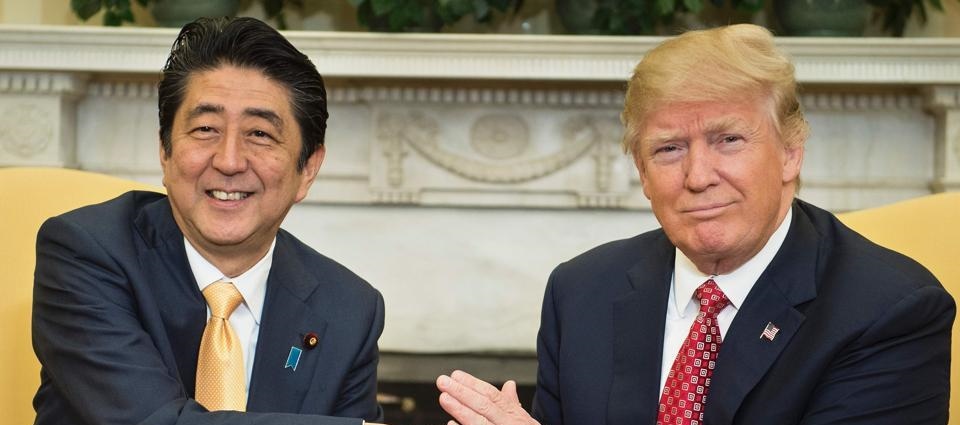Japan-US trade ties intensify
April 20, 2018 | Expert Insights

The United States and Japan governments will work together to intensify trade consultations between the two nations. The aim is to expand trade investments and increase trade ties. Japanese Prime Minister Shinzo Abe and US President Donald Trump announced the agreement in April 2018.
Background
US-Japan trade ties
Japan is currently the US’ fourth largest goods trading partner with $195.5 billion in total (two way) goods trade during 2016. Goods exports totalled $63.3 billion; goods imports totalled $132.2 billion. The U.S. goods trade deficit with Japan was $68.9 billion in 2016. It should be noted that even prior to US President Donald Trump’s election, he had criticized both Chinese and Japanese trade and economic policy as unfair and damaging to the US. He has criticized such trade ties as being detrimental to the US economy.
In January 2017, the total value of U.S. trade in goods with Japan amounted to 15.5 billion U.S. dollars composed of a five billion U.S. dollar export value and a 10.5 billion U.S. dollar import value. In 2017 it was reported that U.S. imports of Japanese vehicles and auto parts surged, sending the U.S. automotive trade deficit with Japan climbing nearly 40% to $5.1 billion.
TPP
The Trans-Pacific Partnership was a free trade agreement between countries bordering the Pacific Ocean. The deal was intended to deepen economic ties by reducing tariffs and to foster trade to boost economic growth. Trump had claimed that the deal was unfair to American workers and farmers. Trump withdrew from the deal on January 23rd, 2017, in his first week in office. After the United States withdrew, there were concerns that the deal would not survive. However, Japan, the next largest economy in the group, took up a leadership position. The remaining 11 nations officially signed the edited trade pact in March 2018.
Analysis
On April 2018, Japanese Prime Minister Shinzo Abe and US President Donald Trump held high level talks in Washington regarding a number of issues including trade. At the end of the visit, Trump and Abe announced that they had agreed to intensify trade consultations between Japan and the US. The goal of these consultations would be to expand investment and trade between the two countries.
"President Trump and I agreed to start talks for free, fair and reciprocal trade deals," Abe said at a joint news conference with Trump. "On the U.S. side, they are interested in a bilateral deal," Abe told reporters. "Our country's position is that TPP is the best for both of our countries," he added, referring to the Trans-Pacific Partnership trade deal.
Trump, meanwhile, iterated once again that the goal would be to address trade deficit between the two nations. “We have a very big deficit and we’re going to weed that down, hopefully get our balance at some point in the not-too-distant future. We will I believe at the end of a very short period of time be able to do certain things. I know they’re ordering large numbers of airplanes ... in the tens of billions of dollars.”
In the recent weeks, President Trump has sent mixed signals regarding his position on the TPP. He has noted that he would be willing to re-join the Trans Pacific Partnership. However, he has also continued to criticize the deal. The other members of the pact have received the announcement with caution. At the time, Japanese Finance Minister Taro Aso told reporters that he would “welcome” US participation in the deal, if Trump’s statements were true. Aso told reporters that Japan’s efforts to restructure the deal “have borne fruit if the United States judged it would be better to rejoin.” Australian, Singaporean, and New Zealand officials have previously been positive on the possibility.
"I don't want to go back into TPP, but if they offered us a deal that I can't refuse on behalf of the United States, I would do it," Trump said. "But I like bilateral better. I think it's better for our country. I think it's better for our workers, and I much would prefer a bilateral deal, a deal directly with Japan," he added.
Japan, however, remains sceptical of bilateral deals. "When two countries negotiate, the stronger country gets stronger," Japanese Finance Minister Taro Aso said late last month, predicting that a bilateral trade deal would cause "unnecessary" pain for Japan.
The announcement came as a relief to investors. The dollar was only slightly weaker at around ¥107.30 when the announcement was made. “The dollar attracted buying versus the yen due to a sense of relief” after Trump is believed to have made no strong request to Abe at the summit regarding trade between the two countries, a foreign-exchange broker said.
Counterpoint
Despite agreeing to intensify talks regarding bilateral deals, Japan may be apprehensive of such deals with the US. Experts have noted that Japan would prefer to shield important industries like farming from foreign competition. However, the US may have the leverage. Unlike many American allies, Japan is still subject to new US tariffs on exports of steel and aluminium to the United States. The Trump administration has imposed a 25% tariff on steel imports and a 10% tariff on aluminium imports.
Assessment
Our assessment is that President Trump who has long propagated protectionist views is keen on restructuring trade ties with major economies like Japan. The main leverage that Washington can use against Japan is the trade tariffs. It is possible that President Trump is also divulging that he is willing to re-join the TPP as a leverage to get Japan to the negotiating table.
However, if the two countries are not able to find a consensus, then it could potentially result in a trade showdown. The US cannot afford to be engaged in hostile trade talks with both China and Japan, two of the largest economies in the world. Would Japan concede to President Trump’s demands?
Read more: China, Japan Improve Ties








Comments